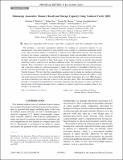Enhancing associative memory recall and storage capacity using confocal cavity QED
Abstract
We introduce a near-term experimental platform for realizing an associative memory. It can simultaneously store many memories by using spinful bosons coupled to a degenerate multimode optical cavity. The associative memory is realized by a confocal cavity QED neural network, with the modes serving as the synapses, connecting a network of superradiant atomic spin ensembles,which serve as the neurons. Memories are encoded in the connectivity matrix between the spins and can be accessed through the input and output of patterns of light. Each aspect of the scheme is based on recently demonstrated technology using a confocal cavity and Bose-condensed atoms. Our scheme has two conceptually novel elements. First, it introduces a new form of random spin system that interpolates between a ferromagnetic and a spin glass regime as a physical parameter is tuned—the positions of ensembles within the cavity. Second, and more importantly, the spins relax via deterministic steepest-descent dynamics rather than Glauber dynamics. We show that this nonequilibrium quantum-optical scheme has significant advantages for associative memory over Glauber dynamics: These dynamics can enhance the network’s ability to store and recall memories beyond that of the standard Hopfield model. Surprisingly, the cavity QED dynamics can retrieve memories even when the system is in the spin glass phase. Thus, the experimental platform provides a novel physical instantiation of associative memories and spin glasses as well as provides an unusual form of relaxational dynamics that is conducive to memory recall even in regimes where it was thought to be impossible.
Citation
Marsh , B P , Guo , Y , Kroeze , R M , Gopalakrishnan , S , Ganguli , S , Keeling , J & Lev , B L 2021 , ' Enhancing associative memory recall and storage capacity using confocal cavity QED ' , Physical Review X , vol. 11 , no. 2 , 021048 . https://doi.org/10.1103/PhysRevX.11.021048
Publication
Physical Review X
Status
Peer reviewed
ISSN
2160-3308Type
Journal article
Description
Funding: Y.G. and B.M. acknowledgefunding from the Stanford Q-FARM Graduate Student Fellowship and the NSF Graduate Research Fellowship, respectively. J.K. acknowledges support from the Leverhulme Trust (IAF-2014-025), and S.G. acknowledges funding from the James S. McDonnell and Simons Foundations and an NSF Career Award.Collections
Items in the St Andrews Research Repository are protected by copyright, with all rights reserved, unless otherwise indicated.

